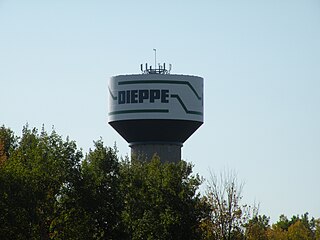
Dieppe is a city in the Canadian maritime province of New Brunswick. Statistics Canada counted the population at 28,114 in 2021, making it the fourth-largest city in the province. On 1 January 2023, Dieppe annexed parts of two neighbouring local service districts; revised census figures have not been released.

Westmorland County is a county in New Brunswick, a province of Canada. It is in the south-eastern part of the province. It contains the fast-growing commercial centre of Moncton and its northern and eastern suburbs. Also located in the county are the university town of Sackville and the local tourist destination of Shediac.

Memramcook, sometimes also spelled Memramcouke or Memramkouke, is a village in Westmorland County, New Brunswick, Canada. Located in south-eastern New Brunswick, the community is predominantly people of Acadian descent who speak the Chiac derivative of the French language. An agricultural village, it has a strong local patrimony, key to the history of the region. It was home to Mi'kmaqs for many years and was the arrival site of Acadians in 1700. A large part of these Acadians were deported in 1755, but the village itself survived.

The Acadian World Congress, or Le Congrès Mondial Acadien, is a festival of Acadian and Cajun culture and history, held every five years. It is also informally known as the Acadian Reunion. Its creator was André Boudreau (1945-2005).

Shediac-Beaubassin-Cap-Pelé is a provincial electoral district for the Legislative Assembly of New Brunswick, Canada. It was created in 1973 as Shediac. Though it has had few geographic changes over the years, it has twice been renamed to more inclusively reflect the communities within its boundaries, first to Shediac-Cap-Pelé in 1994 and then to Shediac-Beaubassin-Cap-Pelé in 2013.

Dundas is a geographic parish in Kent County, New Brunswick, Canada.
Cap-Pelé is a former village in Westmorland County, New Brunswick, Canada. It held village status prior to 2023 and is now part of the town of Cap-Acadie.

Victor E. Boudreau is a New Brunswick politician. He was a member of the Legislative Assembly of New Brunswick from 2004 to 2018, representing the ridings of Shediac-Cap-Pelé and Shediac-Beaubassin-Cap-Pelé for the New Brunswick Liberal Association, and was the Leader of the Opposition in the legislature. In 2023, Boudreau was appointed as the chief administrative officer for the Town of Shediac. In 2024, he was appointed to the Senate of Canada on the advice of Prime Minister Justin Trudeau.

Rogersville is a former village in Northumberland County, New Brunswick, built around the Intersection of New Brunswick Route 126 and New Brunswick Route 440. It was an incorporated village until the end of 2022 and is now part of the village of Nouvelle-Arcadie.
Basse-Aboujagane is a Canadian community, located in Westmorland County, New Brunswick, part of the incorporated rural community of Beaubassin East. The community is situated in southeastern New Brunswick, to the East of Moncton. Basse-Aboujagane is located mainly on Route 933.

Acadieville is a geographic parish in Kent County, New Brunswick, Canada.

Sackville is a geographic parish in Westmorland County, New Brunswick, Canada.
Greater Shediac is the name given to the area encompassing the Town of Shediac in New Brunswick, Canada and its surroundings. Most of this area is a tourist area along the Northumberland Strait mainly on portions of Route 134, Route 133 and Route 950. Some of the areas mentioned below are included in the area of Greater Moncton.
Route 133 is a mostly east/west provincial highway in the Canadian province of New Brunswick.

Shediac is a geographic parish in Westmorland County, New Brunswick, Canada.

Botsford is a geographic parish in Westmorland County, New Brunswick, Canada.

Dorchester is a geographic parish in Westmorland County, New Brunswick, Canada.
Jacques Joseph LeBlanc is a Canadian politician, who was elected to the Legislative Assembly of New Brunswick in the 2018 election. He represents the electoral district of Shediac-Beaubassin-Cap-Pelé as a member of the Liberal Party.

Cap-Acadie is a town in the Canadian province of New Brunswick. It was formed through the 2023 New Brunswick local governance reforms.
















